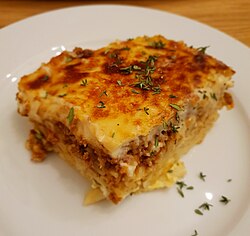Pastitsio (Greek: παστίτσιο, pastítsio) is a Greek baked pasta dish with ground meat and béchamel sauce, with variations of the dish found in other countries near the Mediterranean Sea.
 | |
| Course | Main |
|---|---|
| Region or state | Southern Europe |
| Main ingredients | Ground beef, béchamel sauce |
Name and origin
editPastitsio takes its name from the Italian pasticcio, a large family of baked savory pies that may be based on meat, fish, or pasta, with many documented recipes from the early 16th century,[1] and continuing to modern times. Italian versions include a pastry crust; some include béchamel.[2][3][4][5][6][7][8]
The word pasticcio is attested by the 16th century as "any manner of pastie or pye"[9] and comes from the vulgar Latin word pastīcium[10] derived from pasta, and means "pie", and has developed the figurative meanings of "a mess", "a tough situation", or a pastiche.[11]
In Egypt, it is called macarona béchamel (Egyptian Arabic: مكرونة بشاميل [mɑkɑˈɾoːnɑ bæʃæˈmel, -be-]). In the Albanian-speaking regions of the Balkans, the dish is called pastiçe, deriving from pasticcio. It is, however, often meatless and made with an egg and cheese mixture instead of béchamel. Pastitsio is also found on the island of Cyprus, where Greek Cypriots refer to is as makaronia tou fournou (Greek: μακαρόνια του φούρνου), whilst Turkish Cypriots refer to it as fırında makarna. Both names translate to "macaroni in the oven".
Greece
editThe most recent and most popular contemporary variant of pastitsio was invented by Nikolaos Tselementes, a French-trained Greek chef of the early 20th century. Before him, pastitsio in Greece had a filling of pasta, liver, meat, eggs, and cheese, did not include béchamel, and it was wrapped in filo, similar to the most Italian pasticcio recipes, which were wrapped in pastry. "He completely changed the dish and made it a kind of au gratin".[12]
Tselementes' version—which is now ubiquitous[12]—has a bottom layer that is bucatini or other tubular pasta, with cheese or egg as a binder; a middle layer of ground beef (or a mix of ground beef and ground pork) with tomato sauce, cinnamon and cloves. The top layer is a béchamel or a mornay sauce, with other spices like nutmeg or allspice added. Grated goat cheese is often sprinkled on top. Pastitsio is a common dish, and is often served as a main course, with a salad.[citation needed]
Egypt
editThe Egyptian version is called مكرونه بشمل makarōna bashamel in Egyptian Arabic, i.e. "macaroni béchamel". The dish is typically made with penne or macaroni pasta, a minced-meat sauce with tomato and onion, and a white sauce often enriched with Rumi cheese. Egg or cheese (cheddar and mozzarella)[dubious – discuss] may also be baked on top. The dish was introduced to Egypt by Greek and Italian immigrants in the 19th century.[13]
Malta
editIn Malta, timpana (the name probably derived from timballo) is made by tossing parboiled macaroni in a tomato sauce containing a small amount of minced beef or corned beef, bound with a mixture of raw egg and grated cheese. Hard-boiled eggs are sometimes added. The macaroni is then enclosed in a pastry case or lid before being baked.[14][15] A similar dish without the pastry casing is imqarrun.
See also
editReferences
edit- ^ Bartolomeo Scappi, Opera, 1570, passim: 43 recipes
- ^ Accademia Italiana della Cucina, La Cucina: The Regional Cooking of Italy, pp. 310–313
- ^ Pellegrino Artusi, La scienza in cucina e l'arte di mangiar bene, 1983 reprint, first edition 1891: 10 recipes
- ^ Vincenzo Buonassisi, Piccolo Codice della Pasta, Rizzoli 1973: 11 recipes
- ^ Vincenzo Buonassisi, Il Nuovo Codice della Pasta, Rizzoli 1985 ISBN 8817110388: 41 recipes
- ^ Touring Club Italiano, Guida all'Italia Gastronomica, 1931: 2 recipes; 1984 edition: 3 recipes
- ^ Luigi Carnacina, Luigi Veronelli, La cucina rustica regionale = La buona vera cucina italiana, Rizzoli, 1966: 3 recipes
- ^ Στοΐλη, Μελίσσα (September 25, 2012). "Το αυθεντικό παστίτσιο". Το Βήμα (To Vima) (in Greek). Athens. Retrieved November 13, 2020.
- ^ John Florio, A Worlde of Wordes: Or Most copious and exact Dictionarie in Italian and English, London, 1598 p. 261
- ^ "Pasticcio". Vocabolario della lingua italiana. Treccani. Retrieved 5 March 2014.
- ^ Oxford Paravia Italian Dictionary, 2001, ISBN 0-19-860437-8
- ^ a b Aglaia Kremezi, "Nikolas Tselementes", Cooks and Other People, Proceedings of the Oxford Symposium on Food and Cookery, p. 168
- ^ McWilliams, Mark (7 May 2016). Food and Communication: Proceedings of the Oxford Symposium on Food and Cookery 2015. Oxford Symposium. ISBN 9781909248496 – via Google Books.
- ^ Sheehan, Sean (2000). Malta. Marshall Cavendish. p. 120. ISBN 9780761409939 – via Google Books.
- ^ "Maltese Timpana". SBS Food. 19 August 2013. Retrieved 2019-10-29.
Sources
edit- Babiniotis, Georgios (2005). Λεξικό της Νέας Ελληνικής Γλώσσας. Athens: Κέντρο Λεξικολογίας.